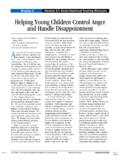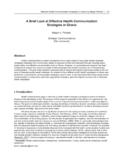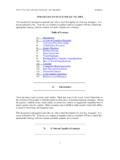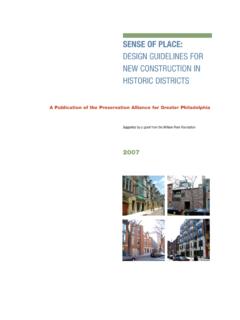Transcription of Uncertainty as a monster in the science–policy interface ...
1 Uncertainty as a monster in the science policyinterface: four coping strategiesJeroen van der SluijsCopernicus Institute for Sustainable Development and Innovation, Utrecht University, Heidelberglaan 2,3584 CS Utrecht, The Netherlands the metaphor of monsters, an analysis is made of the different ways in which the scientificcommunity responds to uncertainties that are hard to tame. A monster is understood as a phenomenon thatat the same moment fits into two categories that were considered to be mutually excluding, such asknowledge versus ignorance, objective versus subjective, facts versus values, prediction versus speculation,science versus policy. four styles of coping with monsters in the science policy interface can bedistinguished with different degrees of tolerance towards the abnormal: monster -exorcism, monster -adaptation, monster -embracement, and monster -assimilation.
2 Each of these responses can be observed inthe learning process over the past decades and current practices of coping with uncertainties in the sciencepolicy interface on complex environmental problems. We might see this ongoing learning process of thescientific community of coping with complex systems as a dialectic process where one strategy tends todominate the field until its limitations and shortcomings are recognized, followed by a rise of one of the otherstrategies. We now seem to find ourselves in a phase with growing focus on monster assimilation placinguncertainty at the heart of the science policy and science society ; monster theory; uncertaintyIntroductionThe knowledge base available for decision-making on global environmental problems inthe context of sustainable development is not of the type of well established knowledgethat one can find in handbooks and textbooks of many disciplinary sciences.
3 It has muchmore a preliminary and partial character and comprises bits and pieces of knowledge thatdiffer in status, covering the entire spectrum from well established knowledge to judg-ments, educated guesses, and tentative assumptions (Funtowicz and Ravetz, 1993;Vander Sluijs, 1997). One could see this type of knowledge base as mixtures of knowledgeand ignorance, where preliminary assumptions, scenarios, and expert judgements maskthe ignorance. This is the case because the complex systems involved are imperfectlyunderstood and imperfectly reduced into models, and yet the policy process requires thebest of our knowledge to support decision-making. Typically, decisions need to be madebefore conclusive scientific evidence is available, while at the same time, the potentialerror costs of wrong decisions can be huge. The paradigm of scientific research aspuzzle-solving within a well defined and unquestioned framework or paradigm meets itslimits the 1980s, computer models are increasingly being used in complex environ-mental assessments and foresight: they enable analysts to simulate reality and run severalscenarios, thereby integrating knowledge from different disciplines.
4 The assumption-ladenness of the models themselves, the use of models, and the transparency of modelshave been criticised over the years. The building of environmental assessment modelsinevitably involves subjective choices and value-laden assumptions. Lack of transparencywith regard to these assumptions and uncertainties, and lack of reflection on how knowl-edge that is conditioned on these models and its assumptions differ from well establishedWater Science & TechnologyVol 52 No 6 pp 87 92 QIWA Publishing 200587knowledge, lead to misunderstandings in the science policy interface on the nature of thistype of knowledge. There is a tendency to treat this knowledge as if it is not differentfrom well established knowledge. The history has many examples of scandals and loss oftrust in the scientific basis for policies based on lack of understanding of the nature ofknowledge stemming from model-based assessment and foresight.
5 A classic example isthe scandal of the IIASA energy scenarios in the eighties. In a critical review of themodels used for these scenarios,Keepin and Wynne (1984)demonstrated convincing evi-dence of informal guesswork and a lack of peer review and quality control, raisingquestions about political bias in scientific analysis , leading to a crisis within the recently the Netherlands National Institute for Public Health and the Environment(RIVM) encountered a similar scandal. Early in 1999, De Kwaadsteniet, a senior statis-tician, accused the institute of lies and deceit in their State of the Environment Reportsand Environmental Outlooks. In a quality newspaper (Trouw) he criticised RIVM forbasing their studies on the virtual reality of poorly validated computer models whileRIVM presents these results as point values with unwarranted significant digits and with-out elaborating the uncertainties.
6 It triggered a vehement public debate on the credibilityand reliability of environmental numbers and models. The case got front page and prime-time coverage in the mass media over a period of several months and led to debate in theNetherlands parliament (Van der Sluijs, 2002). The case triggered a learning processwithin the RIVM and led to the development of a guidance for Uncertainty assessmentand communication for the institute (Van der Sluijset al., 2003).MethodsIn the following, I will use a monster metaphor, borrowed from the work of Dutch philo-sopher of technology MartijntjeSmits (2002, 2004)on the cultural domestication of tech-nologies. I use her monster -concept to explore the way in which the scientific communityresponds to the monstrous uncertainties that they face in the production of the knowledgebase of complex environmental problems. Building on work of MaryDouglas (1966)onpurity and danger in traditional cultures, Smits has developed a theory in which sheexplains the co-existence of public discomfort and fascination with certain new technol-ogies such as GMOs by using the metaphor of a monster .
7 The idea is that we are accus-tomed to order the world in terms of binary categories such as humans versus animals, andorganisms versus machines. Douglas has shown that such categories differ from culture toculture. They are the result of a social learning process. For the most part they are sharedcollectively, therefore they could be called cultural categories. They shape a symbolicalreconstruction of worldly phenomena. A special case of confusion appears, when at thesame moment, a phenomenon fits into two categories that were considered to be mutuallyexcluding. Smits calls this ambiguous phenomenon, this unnatural being, a monster . Forinstance, in xeno-transplantation, the human animal categories get mixed up. The ambiva-lent nature of such a monster induces discomfort and fear. As Smits argues, fear is one ofour reactions to things or situations we cannot understand or control.
8 Fear is connected tothe presentiment of radical unknown dangers. Fascination or reverence is another reactionto the unknown which makes some see, for instance, GMOs as a miracle giving humanityunprecedented opportunities by crossing the species we apply Smits monster concept to the production of a knowledge base forpolicy making on complex environmental problems, we can make a number of interestingobservations. The categories that we thought to be mutually exclusive and that now tendto get increasingly mixed up to create monsters in the science policy interface include:knowledge versus ignorance, objective versus subjective, facts versus values, predictionversus speculation, and science versus van der Sluijs88 Smits distinguishes four styles of monster -treatment with different degrees of toler-ance towards the abnormal. These styles are: monster -exorcism, monster -adaptation, monster -embracement, and finally monster -assimilation.
9 These strategies have someresemblance with strategies distinguished byLakatos (1976)for preserving mathematicalmodels against apparent refutations, which he also called monsters. Lakatos distinguishedfour styles of coping with monsters in models: Surrender (throw the model away andstart all again), monster barring, monster adjustment, and Lemma incorporation. Anotherinstance of monster theory can be found inBoon (1983). In the following, I explore eachof the four strategies distinguished by Smits for coping with the monster of and discussionMonster-exorcismMonster-exorci sts want to expel the monster . Uncertainty simply does not fit within sym-bolical order where science is seen as the producer of authoritative objective call for more objective research that should aim at reducing uncertainties. The bor-ders between facts and values, knowledge and ignorance, science and policy are seen asreal and inflexible and often the categories are also seen as norms (as in the notion that itis a good thing to keep science and policy, facts and values, objective and subjective sep-arated).
10 Yet monster -theory predicts these attempts will prove to be vain in the long run:for each head of the Uncertainty monster that science chops off, several new monsterheads tend to pop up due to unforeseen failure of the monster exorcism strategy to cope with Uncertainty is indeed evi-dent in the history of climate research and earth system research. Initially, climateresearch programmes aimed primarily and explicitly at the reduction of the uncertaintiesin climate forecasting (WCRP, 1979;IGBP, 1992). The belief in the feasibility of thisobjective was so strong that the Intergovernmental Panel on Climate Change (IPCC) sta-ted in their 1990 report that they are confident that the uncertainties can be reduced byfurther research(Houghtonet al., 1990). They were referring to the uncertainties aboutsources and sinks of greenhouse gases, cloud formation, oceans, and ice sheets.









